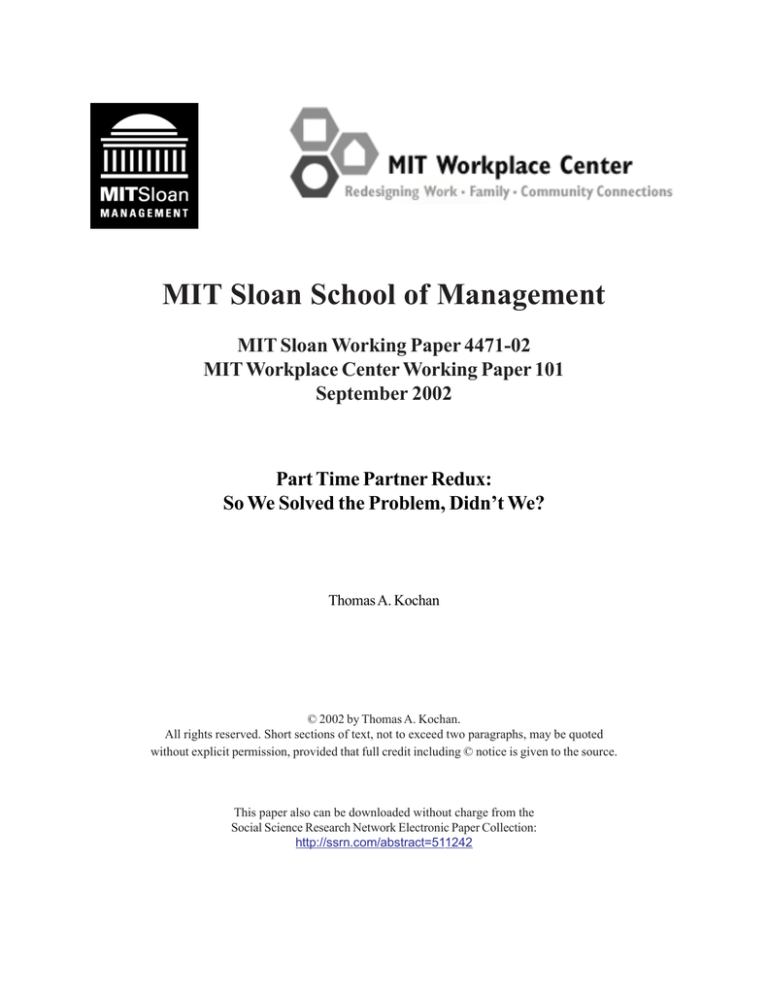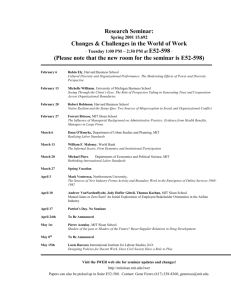
MIT Sloan School of Management
MIT Sloan Working Paper 4471-02
MIT Workplace Center Working Paper 101
September 2002
Part Time Partner Redux:
So We Solved the Problem, Didn’t We?
Thomas A. Kochan
© 2002 by Thomas A. Kochan.
All rights reserved. Short sections of text, not to exceed two paragraphs, may be quoted
without explicit permission, provided that full credit including © notice is given to the source.
This paper also can be downloaded without charge from the
Social Science Research Network Electronic Paper Collection:
http://ssrn.com/abstract=511242
Teaching Case
Part Time Partner Redux:
So We Solved the Problem, Didn’t We?
Thomas A. Kochan
September 2002
WPC#101
For information regarding the MIT Workplace Center or for additional copies of this teaching
case, please email workplacecenter@mit.edu, call (617)253-7996
Please see the list on page 4 of our working papers.
Copyright © 2002 MIT. All rights reserved. This teaching case is for the reader’s personal
use only. This teaching case may not be quoted, reproduced, distributed, transmitted or
retransmitted, performed, displayed, downloaded, or adapted in any medium for any
purpose, including, without limitation, teaching purposes, without the authors’ express
written permission. Permission requests should be directed to workplacecenter@mit.edu.
Abstract
“Part Time Partner Redux: So We Solved the Problem, Didn’t We?”
WPC #101
A teaching case on the reality of part time policies for associates and partners in law
firms. This case shows that formal policies have failed to overcome the informal norms
or culture that penalized professionals for deviating from what was engrained in the
minds of senior partners and others in the profession as the “ideal worker.” It asks the
reader to develop a strategy, considering the different stakeholders, to solve this problem.
Keywords: part-time; parental leave
Contact: Thomas A. Kochan
Email: tkochan@mit.edu
Postal: Massachusetts Institute of Technology (MIT)
Sloan School of Management
Cambridge, MA 02142 United States
Phone: 617-253-6689
Fax: 617-253-7696
My husband's first law firm, one of the most prestigious in the city, offered a
three-month paid parental leave to anyone who had just adopted or had a baby. When
our son Jacob was born, my husband took his full leave because it coincided with the
term I was finishing my PhD dissertation and lecturing for the first time in the Sociology
Department. There is no way I could have accomplished these things without him at
home. It allowed me the maximum amount of time to devote to my writing and teaching.
But it was so unusual for men to take advantage of the leave policy that it hurt him
professionally and he eventually realized that he was going to have to leave the firm if he
was going to advance.
He was at a new firm (equally well known and prestigious) when June was born.
This time he did not dare to take advantage of their equally generous leave policy.
I faced a different type of problem when I was planning my academic career.
After Jacob was born, it became clear to me that I was only going to be able to devote
eight hours a day to my profession if I wanted to live up to my own standards of
parenthood. The problem is, those who are most successful in academia are the ones
who have the freedom to read, think, and work from the moment they get up until they go
to bed. This situation is not going to change, even if it becomes more acceptable to split
one's time between work and family. My guess is the same could be said of careers in
business and medicine. It is certainly true in the world of law, where one bills by the
hour. I find it hard to envision a world where entire fields reduce their standards of
excellence when even a fraction of its practitioners are willing to make that extra effort.
By the turn of the century, nearly 90 percent of law firms had implemented formal
part-time policies for associates and partners. Most thought they had solved the problem
encountered in the part-time partner case.1 Formal policies regarding time and criteria for
promotion, part-time compensation arrangements, and related human resource policies
were in place to support individuals choosing reduced hours option.
But the reality was something else. A study by the Women’s Bar Association of
Massachusetts2 found that:
1. Consistent with the national pattern, over 90% of major Boston firms offered a
part-time or reduced hours option;
2. Less than 5% of associates took advantage of it; less than 2% of all partners
used it.
3. One third of those that used it (and an equal number who did not use it)
believed that it hurt the careers of those using this option because they were
perceived as being less committed to either the firm or their profession than
1
Managing for the Future: Organizational Behavior and Processes. OH: South-Western College
Publishing, 1996 (2nd edition 1999). See Module #7, Pages 63-72.
2
More Than Part-Time. A report of the Employment Issues Committee of the Women’s Bar Association
of Massachusetts. Boston, MA 2000.
MIT Workplace Center
1
Teaching Case WPC#101
those who continued to work full time, long hours;
4. The biggest barrier to use reported in both surveys and focus groups of
lawyers was the stigma attached to breaking the norms of the profession, and;
5. Women constitute 28% of the attorneys in Boston law firms but account for
40% of attorneys leaving these firms. Approximately 40% of those who left
their firm reported the attitudes toward the reduced hours arrangements
affected their decision to leave.
The letter quoted at the opening of this case, written in response to a work family
report,3 captured the real experiences of those who took the parental leave option. The
problem was far from solved. The formal policies failed to overcome the informal norms
or culture that penalized professionals for deviating from what was engrained in the
minds of senior partners and perhaps in the minds of others in the profession as the “ideal
worker.”
Yet there continues to be evidence that a substantial proportion of lawyers would
individually prefer to work shorter hours. But as one study demonstrated, no individual is
likely to take this action as long as others do not follow suit.4 Thus there is a collective
action problem at work here. And, if we take the last point in the quote seriously, even
those who would prefer shorter hours worry that by promoting use of this policy,
standards of excellence in one’s profession may erode.
This is the state of affairs today. Most organizations offer reduced hours options
for family reasons; few people take them, and both those who take them and those who
would like to but don’t because they worry about the negative career stigma it connotes.
Meanwhile, the inability to manage these policies effectively appears to induce high rates
of turnover and all its associated costs of recruitment, training, and lost productivity.
Clearly, this is a problem with multiple stakeholders—employees who, given their
family needs, would prefer shorter hours; managing partners who are concerned about
attracting and retaining talented professionals; clients who want high quality services
when they need them; family members who bear the costs of unusable policies or policies
that add more stress to those who use them. Or, is it an unsolvable trade-off, as the last
sentence of the letter quoted above seems to imply?
The Question
What, if anything, can or should be done to solve this problem? In developing a
strategy, consider both what the different stakeholders might do individually or separately
and what they might do if they worked together in a coordinated fashion.
3
Lotte Bailyn, Robert Drago, and Thomas Kochan, Integrating Work and Family Life: A Holistic
Approach. MIT Sloan School of Management, 2001.
4
R. Landers, J. Rebitzer, and L. Taylor, “Rat Race Redux: Adverse Selection in the Determination of
Work Hours in Law Firms,” American Economic Review 86, 1996, 329-48.
MIT Workplace Center
2
Teaching Case WPC#101
Other Publications from the MIT Workplace Center
Workforce Issues in the Greater Boston Health Care Industry: Implications for Work and Family,
Mona Harrington, Ann Bookman, Lotte Bailyn, and Thomas A. Kochan (#WPC0001)
Enhancing Patient Care Through Enhancing Employee Voice: Reflections on the Scanlon Plan at Boston's
Beth Israel Medical Center,
Mitchell T. Rabkin, MD and Laura Avakian (#WPC0002)
An Employment Policy Agenda for Working Families,
Thomas A. Kochan (#WPC0003)
Work Redesign: Theory, Practice, and Possibility,
Lotte Bailyn and Joyce K. Fletcher (#WPC0004)
Supporting Caring Caregivers: Policy and Practice Initiatives in Long Term Care,
Susan C. Eaton and Barbara Frank (#WPC0005)
Reinventing the Health Care System from Within: The Case of a Regional Physician Network in Germany
Katrin Kaeufer, Claus Otto Scharmer, and Ursula Versteegen (#WPC0006)
Meeting the Family Care Needs of the Health Care Workforce: Reflections on the 1199 Child Care Fund,
Carol Joyner, Executive Director, 1199/Employer Child Care Fund (#WPC 0007)
Bridging the Gap Between Workplace Demands and Family Obligations: Lessons from the United Auto
Workers/Ford Partnership,
Bill Corey, Assistant Director UAW, FSLC and Richard Freeman, Ford Director, FSLC (#WPC0008)
Connecting Work and Family in the Higher Education Workplace: Past Successes, Future Directions,
Kris Rondeau, Organizer, Harvard Union of Clerical and Technical Workers (#WPC0009)
Maintaining a Patient Focus in the Flexible Work Environment
Nancy Kruger, DNSc., RN, and Nancy Hickey, R.N. (#WPC 0010)
Teaching Case
Beyond the Part Time Partner: A Part Time Law Firm?
Brendan Miller, Thomas A. Kochan and Mona Harrington (Teaching Case #WPC0001)
MIT Workplace Center
3
Teaching Case WPC#101







